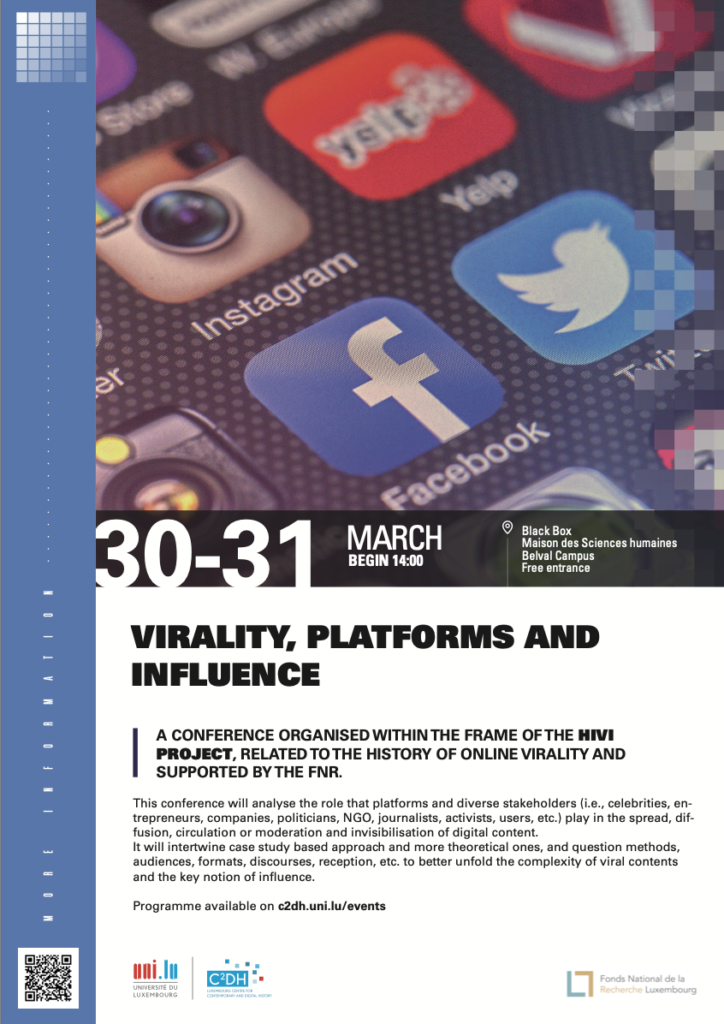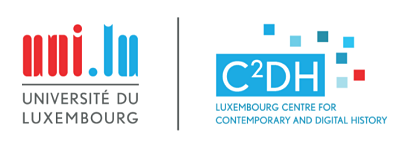The University of Luxembourg hosted the Virality, Platforms, and Influence conference on 30 and 31 March 2023, organized by Fred Pailler and Valérie Schafer (C²DH, University of Luxembourg), within the framework of the HIVI project (see programme).

On 30 March, the audience enjoyed listening to the presentations of the researcher Raffaella Scelzi (University of Bari), Tom Divon, PhD researcher (Hebrew University of Jerusalem), and Bruno Vétel (University of Poitiers) introduced by Alexandre Coutant (UQAM), during the panel “Influence is everywhere”.
Raffaella Scelzi presented “The domestic life turning viral. The female emancipation of cleaning influencer”. Her study focused on female emancipation on social media and the new social dynamics of privacy brought to the public eye through online social media presence. She presented a few examples of influencers leading this trend, such as the YouTuber Jessica Tull with videos of organizing, cleaning, motherhood, and lifestyle, and the cleaning influencer Giulia Gropo, who, in her opinion, marked a counter-trend to luxury shown by fashion bloggers. They create a new public space where public and private merge becoming the realm of freedom. The author presented the concept of a platform society, where there is a systemic relationship between online platforms and social structures. The cleaning influencers’ new creation and peculiarity is to make their ordinary life “live” using vernacular creativity.
On the other hand, Tom Divon presented: “Can we learn about the Holocaust in 60 seconds? Modes of historical storytelling on TikTok.” As a media scholar, he focused on the memory of the Holocaust on TikTok and how users can communicate these socio-political affairs in engaging ways through digital storytelling, using the playfulness of the Social Media app. In his presentation, he talked about the challenge #POVHolocaustChallenge, in which they act as a person who died in the camps to give them a voice, or the ‘I Remember When” challenge, as examples of the different types of videos used to talk about the Holocaust on the platform. He highlighted how with TikTok, younger generations could actively participate in a renewal of the commemoration culture of the Holocaust through peer-to-peer education and a strategic understanding of the app’s algorithm and vernacular.
Bruno Vétel presented “Player’s virtual assets circulation in a Massively Multiplayer Online Games. A focus on the sociotechnical player-character assemblage”. The researcher talked about digital circulation in media platforms versus video gaming and the difference between digital media platforms and video gaming platforms as a way to move the reflection about virality from a media and communication context to a gaming context. While the first is characterized by a non-rivalrous information design, the second is by rivalrous mechanisms based on digital assets with artificial scarcity. He also questioned how particular constraints produce specific digital asset circulations. He then distinguished between intra-server virtual assets circulation – illegal in-game circulations through a third-party e-commerce website; and inter-server virtual assets circulation, a client-server network architecture that encloses the player’s character in a finite geographical space. The circulations of virtual assets occur during inter-servers’ migrations of the player’s character. He also discussed the typology of the player’s character circulation, circulation rhythms, and virtual assets.
Richard Rogers, holder of the Chair in New Media and Digital Culture at the University of Amsterdam, closed the day with his keynote “Platforming, deplatforming, replatforming. For whom does it work?”, moderated by Fred Pailler. He presented his work on “deplatforming” far-right and alt-right social media users due to controversies and criticism surrounding them due to their use of “angertainement” to gain a large following. In his keynote, he explained how specific social media sites have removed controversial users from their sites, such as Donald Trump’s Twitter ban. Rogers explained how the problematic users migrate to other social media such as Telegram or Gab as a result of this “deplatforming” used to cleanse and purge their sites from potential real-world harm. Rogers raised many thought-provoking questions regarding the potential risks of “deplatforming” : it may create even more mystery and paradoxically draw even more attention to the problematic users (e.g. the Streisand effect) and the morality surrounding the respect of free speech.
On the 31st, March Tommaso Venturini (Medialab, University of Geneva; Centre for Internet and Society, CNRS), opened the day with his keynote, Memecry: repetition-with-variation in online subcultures, moderated by Valérie Schafer. He talked about the notion of secondary orality as a way to look at online communication and rethink what writing and sharing in digital environment. He claims online communication is akin to evanescent communication, much like in oral-based cultures. As online posts work by addition and not subordination, it is through repetition that we create a sense of truth and validation. He researched the site 4chan, where he looked into “memecry”, which looks into the effect of mimicry and the dynamics of repetition-with-variation of Internet memes, through the study of set formulas and words used together.
The last part of the conference, chaired by Catherine Tebaldi (University of Luxembourg) was related to “Politics of Influence”, with the presentations of Maël Pégny (University of Tübingen); Nelly Quemener (CELSA – Sorbonne University); and Thibault Grison (CELSA – Sorbonne University).
Maël Pégny presented Is virality a digitally native concept? Issues for history of information flow and political debates. He started his talk by discerning the definition given to the concept of “virality” by Nahon and Hemsley, who made the digital nature of virality implicit in their definition. He distinguished between three concepts of virality and three different historical periods: first, word of mouth, and its possible manipulation(distinguish conversations, mail, telephone, recording, etc.); secondly, pre-Machine Learning social networks and their affordances for cheap and fast sharing; and finally, post-Machine Learning social networks with predictive modelling. He emphasized the importance of distinction with word of mouth, with characteristics such as: iterative one-to-many communication, greater reception-sharing speed, drastic diminution of cost copying-sharing, etc. He emphasized that digital communication, and especially post-ML social networks, relies on the privatisation of the public space. For instance, we don’t have details on how Facebook’s Machine Learning moderation tool works, and thus on how conversations happen on it.
On the other side, Nelly Quemener presented her research “Reactive communities and affective hype: a methodological proposal to seize the formation and circulation of ‘anti-system’ assertions on a Youtube channel” on the controversial French comedian Dieudonné whose online presence and antisemitism fueled criticism from French society. She explained how mainstream media acts as the first “pole of reactivity.” As she studied comments left on Dieudonné’s YouTube videos, she analysed “profiles of activity,” which allowed her to look into the level of users’ involvement through the intensity of their reactions in the threads. She showed that there is not a fan base per se around the videos, and that these videos gather a more defensive, reaction-based community either for or against Dieudonné and his anti-system ethos.
Finally, Thibault Grison, who is currently studying the rise of the use of censorship or “shadow banning” on the social media TikTok regarding content on the LGBTQI+ community, presented “Playing hide and seek with the algorithm: a story of shadowbanning and abusive censorship on TikTok,”. His study is focusing on a techno-semiotic approach, on the app’s algorithm biases and looking into how users are getting more cunning and finding creative ways to work around it to allow them to still be visible on the app regardless of possible discrimination regarding the topics spoken about.
For two days, scholars from different disciplines discussed the role of platforms and diverse stakeholders (i.e., celebrities, entrepreneurs, companies, politicians, NGOs, journalists, activists, users, etc.) in the spread, diffusion, circulation, moderation, and invisibilisation of digital content, on the basis of fieldworks and analyses of online influence and influencers.
The presentations showed that online platforms hold a paradoxical position as they are spaces that allow users of different opinions to express themselves, while their own regulation politics plays a major role in how users’ expression become visible and debatable. On the one hand, a platform can be used as a way to find emancipation in ordinary housework or to create a stronger sense of community within certain groups. Nonetheless, on the other hand, the growing tensions between users, communities or even between the users and the platforms are obvious.
Whether it was about affordances, “community policies”, content moderation algorithms, or the combination of all these elements, the speakers demonstrated how platforms engage with the shaping and framing of conversations and with the ability of groups and communities to grow, survive and define themselves. As examples of this, one may think of the censorship of specific communities, such as the LGBTQI+ community, which created a particular way of communication tailored to the platform’s algorithm, or of the deplatforming of certain far-right users, deemed controversial and problematic and who migrated to other platforms.
Most of the presentations allowed for a better understanding of the different dynamics at stake, between the platforms, their guidelines, and their users, and speakers paid particular attention to perceptive and affective dynamics in online publication and dissemination. This led to fruitful methodological discussions about combining or not qualitative and quantitative methods or working on phenomena that stretch between distinct platforms.
Emily Griffin and Carmen Noguera
